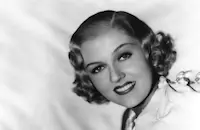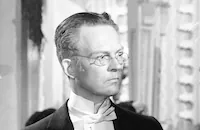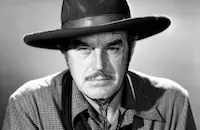Circus Clown

Brief Synopsis
Cast & Crew
Ray Enright
Joe E. Brown
Patricia Ellis
Dorothy Burgess
Donald Dilloway
Gordon Westcott
Film Details
Technical Specs

Synopsis
Chuckles Howard, a former circus clown who now runs a hotel, has kept his son Happy away from all contact with the circus, but unknown to his father, Happy has been practicing tumbling and is nurturing a secret desire to join the circus. When the circus is in town, Happy sneaks away to see it and ends up seated next to his father. Enjoying the show, Happy sees a small child, Dickie, run into the path of the oncoming horses and rescues him. Alice Madison, a trapeze artist, who appears to be Dickie's mother, thanks him profusely. Happy becomes enamoured with "Millie La Tour," one of the bareback riders, unaware that she actually is a man dressed as a woman. Thinking that it is a good joke, Millie encourages Happy's attentions. Despite his father's wishes, Happy runs away with the circus. He continues to be the butt of everyone's jokes, however, and his only friends are Dickie, Alice and the lions. Happy asks Alice to intercede with Sheldon, the owner of the circus, to get him a job. When he overhears her pleading with Sheldon to give someone a chance, he assumes she is talking about him, but she actually is asking for a second chance for her brother Frank, Dickie's father. From inquiries, Happy learns that Frank started drinking after his wife fell out of his hands to her death. He also learns that Dickie is not Alice's child and that Alice is not even married. By accident, Happy performs his tumbling act in the ring, where Sheldon sees him and offers him a contract. Everything seems to be going well until Happy sees Frank take a drink before his performance. He enters Frank's tent and takes the bottle away from him, but when Alice follows him inside, he pretends that he was the one drinking, so that she will not worry about her brother. Unused to drinking, Happy gets drunk and Sheldon fires him. Happy returns home, but misses the circus so much that he decides to make Frank tell Alice the truth about what happened. He finds Frank drunk, knocks him out and takes his place in the show. Happy does the routine perfectly, and realizing what happened, Alice gives him a big kiss at the end of the show.

Director
Ray Enright
Cast

Joe E. Brown

Patricia Ellis

Dorothy Burgess

Donald Dilloway
Gordon Westcott
Charles Wilson

Harry Woods
Ronnie Cosby
John Sheehan
Spencer Charters
Tom Dugan
Earl Hodgins
Gordon Evans
Bobby Caldwell
Poodles Hanneford
Alfredo Codona

William Demarest
Lee Moran
Ernest Clark

William Davidson

Ward Bond
Crew
Wesley Anderson
E. A. Brown
Tom Buckingham
Paul Burnett
Leo F. Forbstein
Esdras Hartley
Sid Hickox
Bert Kalmar
Clarence Kolster
Vernon Larson
Stanley Logan
Mickie Marigold
L. P. Mashmire
Howard Ogle
Orry-kelly
Harry Ruby
James Seymour
Paul Gerard Smith

Film Details
Technical Specs

Articles
The Circus Clown
There's more than a touch of autobiography in the comic story. In 1902, at the age of ten, Brown joined a circus tumbling act with the blessings of his parents, unlike the character he plays here. While touring in various circus troupes and in vaudeville, he began adding comedy to his act, becoming popular enough to land a movie role in, fittingly enough, The Circus Kid (1928). The part, however, did not draw on his comic skills; in fact, his lion tamer in that film, King Kruger, ended up dying tragically. The following year, he signed with Warner Brothers, where his talents were far more wisely used, and he finally got the chance to show off his acrobatic as well as comedic skills in The Circus Clown. Articles and reviews around the time of the picture's release claimed Brown did all his own stunts, although there have been conflicting reports about whether he actually performed the climactic trapeze act or used a double.
One bit the actor did do himself involved his character inside a lion's cage, and the look of fear on Brown's face was no doubt real. Although very tame, the lion affectionately pawed Brown on the arm, requiring six stitches. "After that I had to go on with the act and lie on a couch while the lion came up and licked my feet," Brown later related. "They put honey on my feet to entice him but there was nothing to discourage him from taking a bigger bite. ... That one turned out all right though. When the lion finished licking the honey off my feet, he came over and put his two large paws on my chest and then put his head down as though he was sorry he hurt me. It was so good, such a 'touching' scene, they rewrote the whole sequence to fit it."
Brown also recounted a story about his encounter with an elephant used in The Circus Clown. The script required him to walk over to the aged animal and say, "Up, up, old girl," in order to be lifted on the elephant's back. The trainer told him it would take several tries before the animal responded to him, but the trick happened instantly. Apparently, when the elephant was still a baby some 30 years earlier, she and Brown had played together in a circus where they were both employed. "And she remembered me. If you saw that picture and remember how smooth the elephant sequences were, this was the reason."
The story and screenplay were by Bert Kalmar and Harry Ruby, the Hall of Fame songwriting team responsible for such hit standards as "Who's Sorry Now?", "I Wanna Be Loved by You" (sung by Marilyn Monroe in Some Like It Hot), and "Three Little Words," also the title of the 1950 musical biography in which the duo were portrayed by Fred Astaire and Red Skelton. The two also collaborated, along with others, on the scripts for the Marx Brothers hits Animal Crackers (1930), Horse Feathers (1932), and Duck Soup (1933). They wrote the song "Hail, Fredonia" for the latter film. None of their songs were used in The Circus Clown.
The film's working title prior to release was "Sawdust." Some scenes were filmed at the Al G. Barnes' circus at El Monte, California.
Director: Ray Enright
Screenplay: Bert Kalmar and Harry Ruby
Cinematography: Sidney Hickox
Editing: Clarence Kolster
Art Direction: Esdras Hartley
Cast: Joe E. Brown (Happy Howard), Patricia Ellis (Alice), Dorothy Burgess (Babe), Don Dillaway (Jack), Gordon Westcott (Frank).
BW-65m.
by Rob Nixon

The Circus Clown
Quotes
Trivia
Notes
The film's pre-release title was Sawdust. Alfredo Codona and Poodles Hanneford were circus stars. Some contemporary sources credit William Davidson with the role of "Kingsley." Some scenes were filmed at the Al G. Barnes' circus at El Monte, CA.















